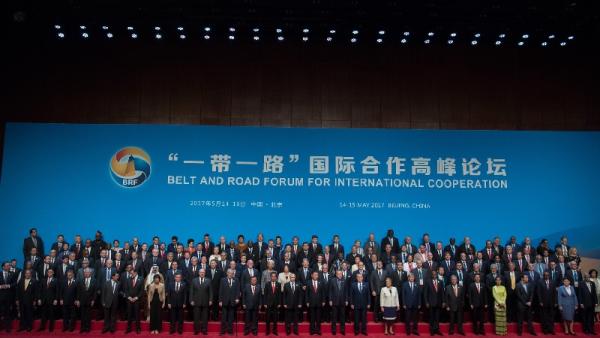
James Laurenceson, Deputy Director, Australia-China Relations Institute, University of Technology Sydney |

Xunpeng Shi, Principal Research Fellow, Australia-China Relations Institute, University of Technology Sydney |
This article appeared in The Diplomat May 19 2017.
China’s massive Belt and Road Forum wrapped up in Beijing on Tuesday. At its conclusion, Australia’s representative, Trade and Investment Minister Steve Ciobo, issued a guarded statement.
He echoed Australian business in welcoming the trade and investment opportunities that the Belt and Road Initiative (BRI), which centers on improving connectivity between and within countries, would create. But Ciobo added that the benefits would only be maximized if a 'transparent, collaborative, and planned approach is followed.' He also called for a 'level playing field based on market principles and adherence to best practice in financing.'
Ciobo is surely correct to emphasize the importance of all these areas. What’s curious, however, is that a joint communique issued by the 29 state and government leaders attending the summit endorsed the same principles.
This raises the obvious question: what exactly is stopping the Australian government from more proactively engaging with China on what President Xi Jinping described earlier this week as the 'project of the century'?
Recall that when Chinese Premier Li Keqiang visited in March, Australia declined to formally endorse the BRI or link it with Australian government plans such as the Developing Northern Australia strategy.
The New Zealand government showed no such hesitation, inking a Memorandum of Understanding (MOU) on BRI cooperation as soon as Li touched down in Wellington after leaving Sydney. Singapore, another like-minded Australian partner in the region, also signed an MOU with China on BRI cooperation earlier this week.
And while some Australian commentators might take comfort from few other Western leaders attending the Beijing summit, it shouldn’t be missed that Indonesian President Joko Widodo was there representing ASEAN’s largest economy. Similarly, the leaders of Malaysia, the Philippines, and Vietnam were on hand, despite their heated territorial disputes with China in the South China Sea.
At the very least, what this neighborhood response shows is that Australia needs to develop its own clear-eyed understanding of what the BRI is about. Reservations expressed by others, notably the United States, must be judged carefully.
After all, the United States also asked Australia not to join the Asian Infrastructure Investment Bank (AIIB), claiming that it was a unilateral Chinese initiative set to have poor standards of governance. These claims have proven entirely unfounded.
The big U.S. fear about the BRI is that it is a Chinese geostrategic play designed to usurp Washington as the dominant power in Asia. Leave aside the argument put by former Prime Minister Paul Keating last August that China’s economic rise means U.S. hegemony is 'incapable of preservation'; there’s little evidence China has nefarious hidden plans for the BRI.
Sun Tzu, in the classic 2,500 year old Chinese strategy text The Art of War, counseled, 'Let your plans be dark and impenetrable as night, and when you move, fall like a thunderbolt.' Yet the BRI was first announced in 2013 by Xi in a speech to the Indonesian parliament: not exactly clandestine. And since then, Chinese state media have touted the BRI at every opportunity. Sun Tzu would be horrified. Or perhaps, the BRI is mostly not about geostrategic competition after all.
There’s another big problem with the idea that the BRI is about countering U.S. power in Asia: the United States is invited to take part. So is everyone else. It was two years ago at the 2015 Boao Forum for Asia in Hainan that Xi said the BRI was intended to be 'open and inclusive' and build on existing initiatives, not replace them.
Australia would also do well not to read too much into the current lack of detail around the BRI. The Chinese don’t know the details either. In fact, as Jane Golley from Australian National University has pointed out, if you ask around in China what you’ll find is various understandings and vigorous debate about almost every important aspect of the BRI.
Jason Young, director of the New Zealand Contemporary China Research Center, explained last month that the Chinese approach to grand planning tends to be highly aspirational with flexibility deliberately built in.
He said that what this means for countries participating in the BRI, particularly advanced economies like Australia, is a 'blank page clause' whereby specific projects can flow from bilateral negotiations following the signing of an MOU.
Earlier this year, ratings agency Fitch counted $900 billion in BRI projects either started or in the planning stages. In his summit welcoming address on Sunday, Xi committed a further $150 billion to the scheme. But for now, Australia remains a bystander with no input into how the Belt and Road will unfold.
Authors
Professor James Laurenceson is Deputy Director of the Australia-China Relations Institute at the University of Technology Sydney.
Xunpeng Shi is a Principal Research Fellow at the Australia-China Relations Institute, University of Technology Sydney and an Adjunct Senior Research Fellow at the Energy Studies Institute (ESI), National University of Singapore.


